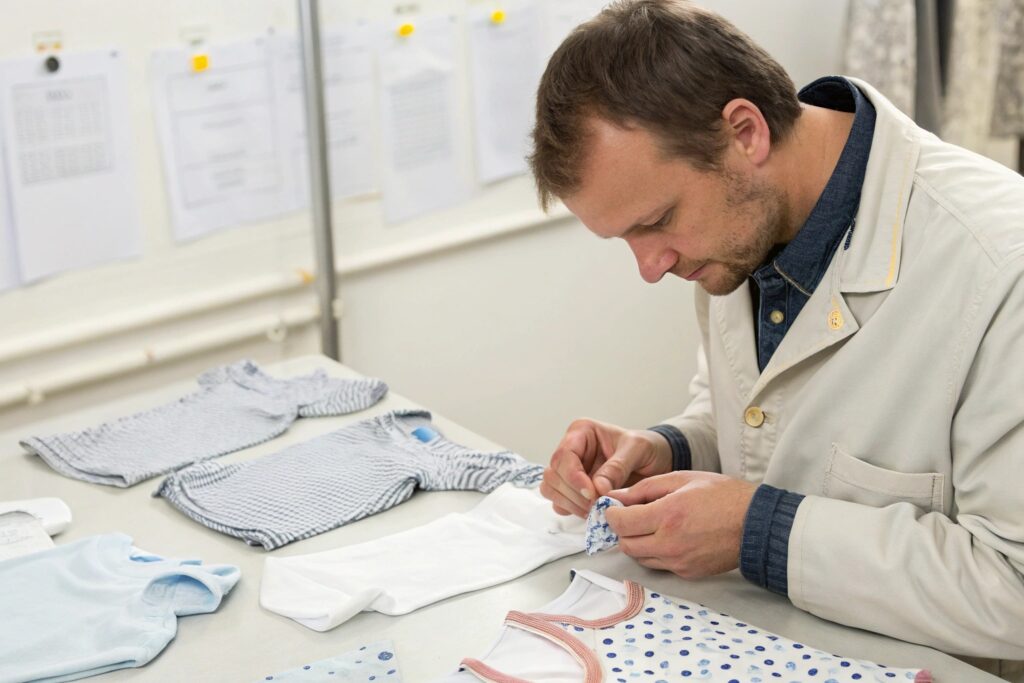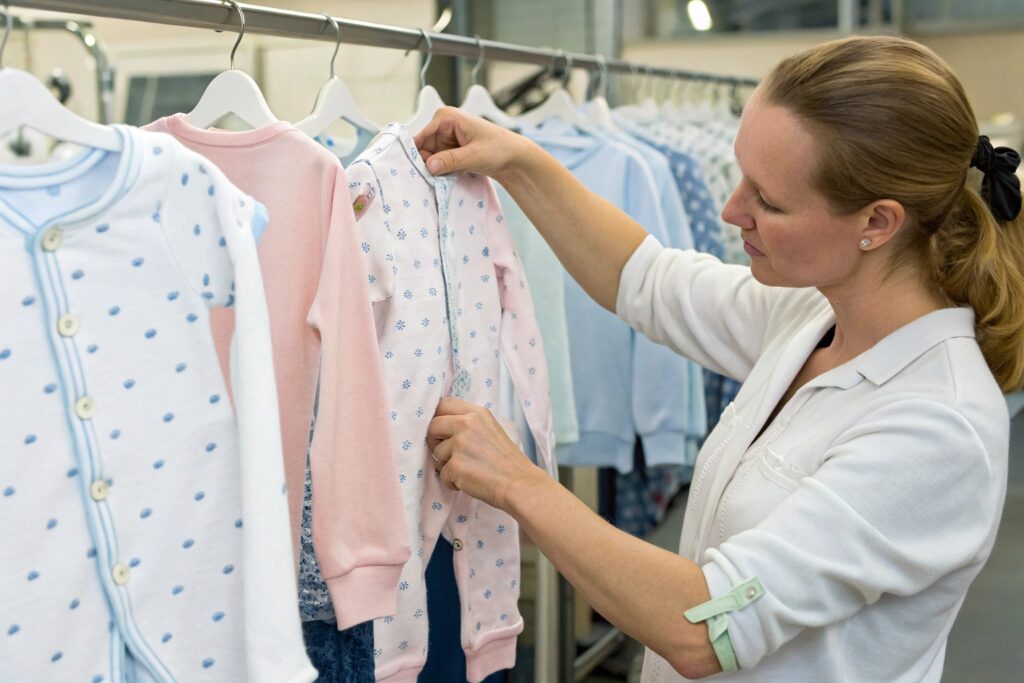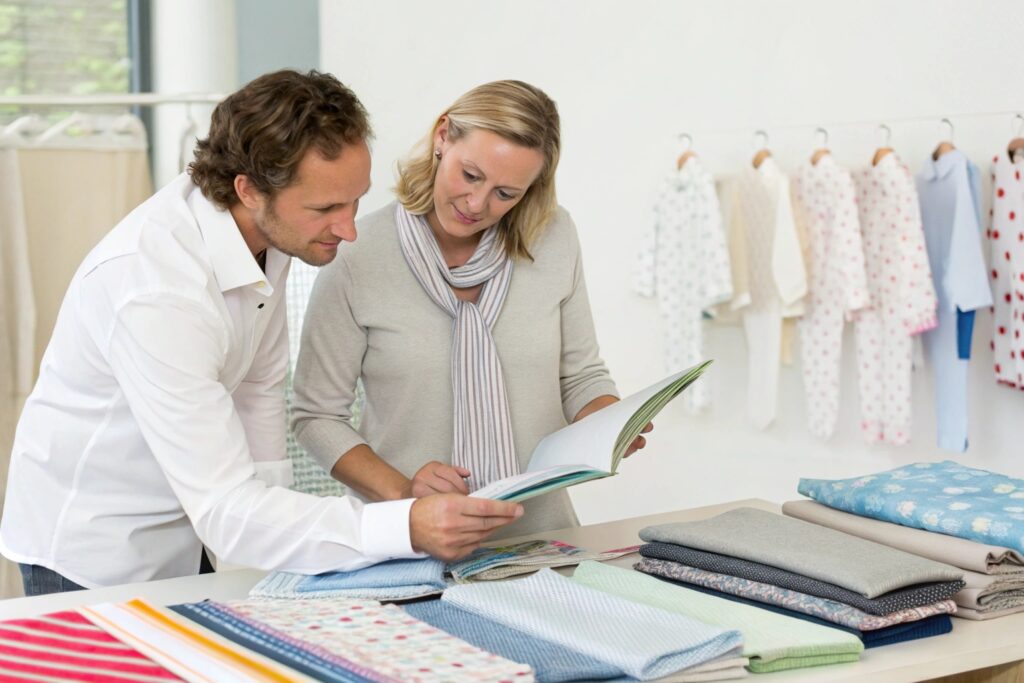Custom babywear is in high demand—but scaling it to thousands of pieces safely is a challenge that brands can’t afford to ignore.
To scale custom babywear safely, you need strict compliance testing, trained manufacturing partners, and a process that balances creative design with certified safety standards.
In this article, I’ll share how we help brands grow their custom babywear lines while keeping every piece soft, safe, and regulation-ready.
How to Maintain Safety Standards in Large-Scale Production?
As orders grow, so does the complexity. More SKUs, more styles, more sizes—and more chances for quality or safety to slip.
The key to maintaining safety at scale is building safety checkpoints into every stage of your production workflow, from sourcing to final packing.

What risks increase when custom babywear goes from 300 to 30,000 units?
Here are the most common issues we help brands avoid:
| Production Risk | Safety Impact |
|---|---|
| Inconsistent snap placement | Choking hazard or garment failure |
| Sharp overlock seams | Skin irritation or scratches |
| Dye lot mismatches | Non-compliant or unstable fabrics |
| Incorrect label application | Missing CPSIA tracking, recalls |
| Wrong fabric substitutions | Unapproved material, chemical exposure |
As volume increases, you can’t rely on spot checks. At Fumao, we set up multi-point QC with checklists at each stage—including post-customization reviews for embroidery, printing, and labeling.
How do we maintain safety during peak production seasons?
Even in rush periods, we keep babywear safe by:
- Pre-approving all trims, fabrics, and tags before cutting
- Assigning trained QC supervisors for custom orders
- Using fixed CPSIA-compliant tracking label templates
- Limiting daily output per line to ensure inspection windows
- Flagging any deviation from original tech pack for re-approval
Scaling doesn’t mean cutting corners. It means preparing for growth with the right controls in place.
What Compliance Tests Are Essential for Custom Babywear?
Custom garments don’t get a pass just because they’re unique. Every piece still has to meet the same safety laws as standard mass-produced babywear.
For babywear sold in the U.S. and EU, essential compliance includes CPSIA, OEKO-TEX®, flammability testing, small parts testing, and tracking label regulations.

What compliance tests are legally required for infant clothing?
Here are the key tests we run for every babywear client:
| Test Type | What It Ensures |
|---|---|
| CPSIA (U.S.) | Lead-free snaps, flammability safety |
| 16 CFR 1501 | No small detachable parts (choking risk) |
| OEKO-TEX® Standard 100 | Free of harmful substances and dyes |
| EN 14682 (EU) | No dangerous cords or ties |
| Shrinkage and Colorfastness | Fabric won’t deform or bleed when washed |
For personalized products (like name prints or embroidery), we run rub tests, wash durability, and logo print safety evaluations too.
What documents should brands keep to prove compliance?
Every brand should request and store:
- Lab testing reports for fabric, trims, and final product
- CPSIA tracking label samples with batch IDs
- OEKO-TEX® or GOTS certificates (if organic)
- A compliance file per SKU (including tech pack + testing proof)
- Signed approval forms for pre-shipment inspection
At Fumao, we compile all of these into one compliance folder per order. That’s how we help brands pass customs and audits without stress.
How to Train Factories for Consistent, Safe Customization?
Not all factories are ready for personalization. Names, embroidery, unique trims—they all introduce new risks.
To scale safely, brands need to work with trained manufacturers who understand how custom elements affect garment safety, stitching, and compliance.

What training does a babywear factory need before handling custom orders?
Here’s what we do internally:
| Training Topic | Why It Matters |
|---|---|
| CPSIA & EU safety rules | Aligns factory staff with compliance |
| Print and embroidery placement | Avoids pressure points, choking zones |
| Trim strength and QC | Ensures secure snaps and buttons |
| Labeling and packaging rules | Prevents customs rejections |
| Tech pack accuracy checks | Keeps custom specs consistent at scale |
We also create custom checklists per client, so even new workers understand how to handle specific brand elements—like a hem label or a signature gift pouch.
How do we integrate customization into the QC process?
For every customized babywear order, we:
- Create pre-printed templates for embroidery/print placement
- Use batch-level inspection for printed names or logos
- Confirm thread/fabric contrast and wash-fastness
- Assign experienced staff to oversee personalization lines
- Photograph samples before bulk embroidery or heat press
A personalized romper may look simple—but if the print peels or the embroidery scratches the baby’s skin, your brand’s reputation suffers. That’s why we treat every unit like a flagship.
Balancing Creative Design with Infantwear Safety Regulations?
When creativity meets regulation, it takes experience to get both right. Parents want cute, and safe. You need to deliver both.
The best custom babywear combines smart design with materials, trims, and silhouettes that meet infant safety standards worldwide.

What design features are commonly rejected for safety?
These creative elements might look great—but need modification:
| Design Element | Why It’s Risky |
|---|---|
| Long ribbons or cords | Strangulation risk (EN 14682 violation) |
| Small sewn-on beads or buttons | Choking hazard for infants |
| Hard vinyl or glitter prints | Poor breathability or chemical exposure |
| Overstiff collars or seams | Irritation and mobility restriction |
| Large unsecured appliqués | Risk of detachment during washing |
We help brands rework designs by:
- Swapping ribbons for decorative stitching
- Using embroidered names instead of iron-on decals
- Replacing hard logos with soft woven tags
- Reinforcing all trims with secure stitching + pull testing
We also simulate real use: “What happens if a baby chews on this print? Tugs this patch? Sleeps in this fabric?”
That’s the thinking that turns good design into long-term trust.
How do you communicate design safety with your factory?
Here’s what works:
- Add a “safety notes” section in your tech pack
- Include visuals showing proper placement and trim rules
- Request a fit test video of the final sample on a mannequin
- Get a revised sample if safety guidelines were missed
- Ask for a QC video before shipping—especially for new SKUs
At Fumao, we create side-by-side design vs. safety breakdowns, so the creative vision never comes at the cost of safety.
Conclusion
Scaling custom babywear takes more than production capacity—it takes care, knowledge, and a quality system built around infant safety. With the right factory partner and process, you can grow your brand while keeping babies safe—and parents loyal.










